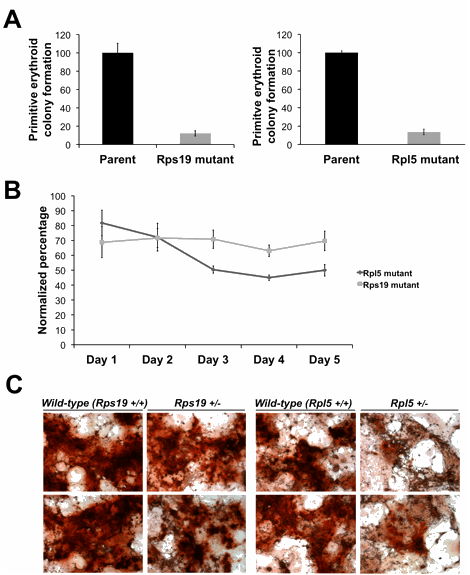Abstract
Diamond Blackfan anemia (DBA) is a rare inherited bone marrow failure syndrome characterized by red blood cell hypoplasia, congenital anomalies and cancer predisposition. In addition, short stature and poor skeletal growth are found in a subset of DBA patients, suggesting similar developmental abnormalities in erythropoiesis and osteogenesis in that subset. Furthermore it has been shown recently that osteoblasts secrete erythropoietin, linking the marrow niche to the modulation of erythropoiesis. DBA has been shown in the majority of cases to result from haploinsufficiency of large or small ribosomal subunit proteins. The p53 pathway, known to be activated by abortive ribosome assembly, contributes to the erythroid failure of DBA. We studied two DBA genotypes in vitro using murine embryonic stem (ES) cell lines harboring gene trap mutations in ribosomal proteins RPS19 and RPL5, respectively. Both mutants had decreased embryoid body (EB) formation, decreased definitive erythroid colony formation and similar p53-dependent primitive erythroid differentiation defects (see Figure A). Cell cycle analyses were normal in the Rps19 mutant ES cells, but there was a significant G2/M arrest in the Rpl5 mutant ES cells, which was unaffected by p53 knockdown. In addition, the Rpl5 mutant cells had a more pronounced growth defect in culture compared to the Rps19 mutant cells (Figure B). ES cells were differentiated, in vitro, to osteoblasts using established culture conditions, and confirmed both by morphology and molecular characterization (e.g. RUNX2 and Osteopontin). Following 14 days of osteogenic differentiation, bone mineralization was confirmed via Alizarin Red staining. A marked reduction in Alizarin Red staining was seen in the Rpl5 mutant cells while there was only a slight diminution of staining in the Rps19 mutant ES cultures (see Figure C). Therefore the erythroid differentiation defect appears similar in both the Rps19 and Rpl5 mutant ES cells. However the Rpl5 mutant appears to have a more severe phenotype at the ES stage, as evidenced by a pronounced p53-independent G2/M arrest and slower growth rate and subsequently during osteogenic differentiation. These data suggest an explanation for the more severe non-erythroid phenotype seen in a subset of DBA patients.
No relevant conflicts of interest to declare.
Author notes
Asterisk with author names denotes non-ASH members.


This feature is available to Subscribers Only
Sign In or Create an Account Close Modal